enrollment
3 College Recruitment Strategies for Success This Fall… and Beyond
In recent blogs and webinars, we have discussed recruitment and outreach strategies that institutions have needed to quickly put place in order to successfully enroll the fall 2020 class. But what do institutions need to do more broadly in order to have a successful fall 2020?

Like the recruitment-related initiatives, the next three critical initiatives all focus on expanding access virtually. I can’t pretend that these aren’t huge undertakings. I believe that investing in these initiatives will prepare us for an increasingly uncertain future—future pandemics, the next natural disaster, or “just” the evolving demands of our students. These initiatives will broaden the appeal of institutions as students come to demand greater flexibility and convenience from the institutions in which they enroll.
To date, we have seen that those institutions that are well versed in serving adult, graduate, and online students are best positioned to contend with today’s realities. These initiatives will help to ensure that institutions are better prepared to serve their traditional students in an era of social distancing, and to be optimally positioned to serve a potential influx of adult and other post-traditional students caused by the recession that is almost certainly on the way.
Will the adult students return?
Over many decades it has become conventional wisdom that adult enrollment (both undergraduate and graduate) runs counter-cyclical, increasing when the economy is bad. However, consider the following:
A) At the graduate level, the 2010 recession did indeed have a positive impact on enrollment. When tracking degree production, subsequent years were stronger than ever—and got even better once the recession was well-passed. This endorsed the counter-cyclical argument.
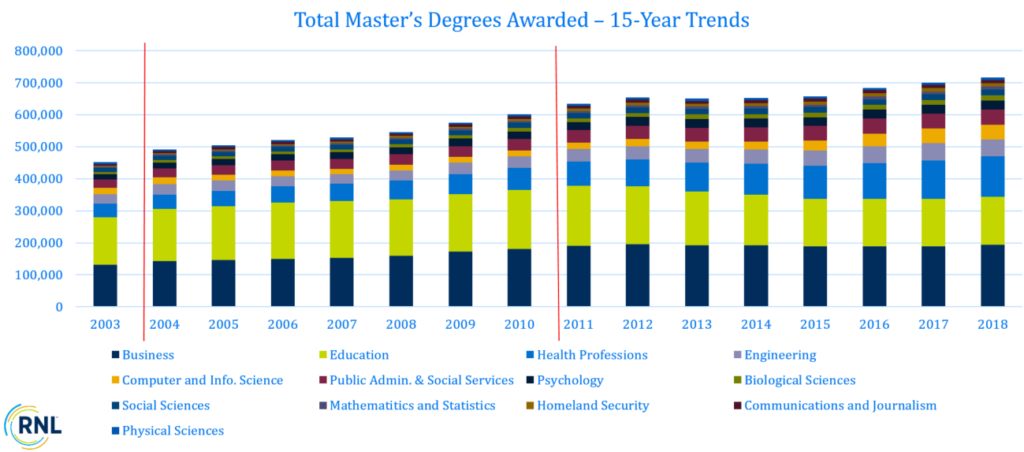
B) At the undergraduate level, as dozens of continuing or adult education leaders will attest, the same was not true. In fact, our institutions saw declines in both total adult (25+) enrollment and adult enrollment as a portion of total enrollment.
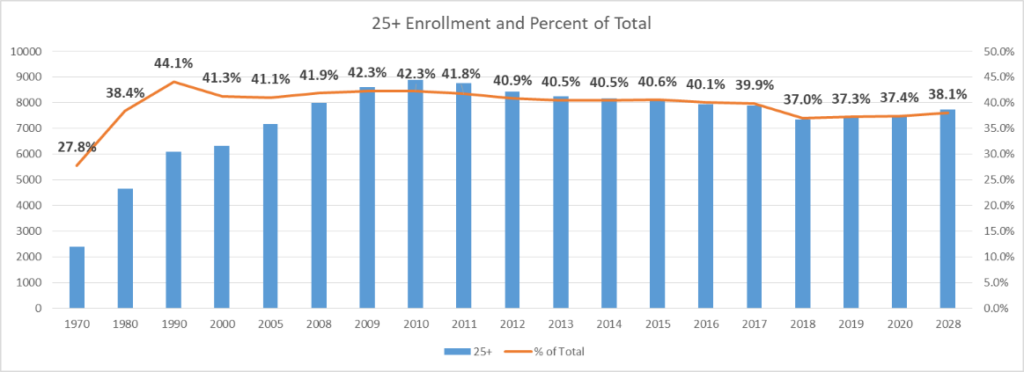
Why? A set of Brookings studies indicate that the recession did not affect all Americans equally. Rather, the higher the socio-economic background, the less likely an individual was to be negatively affected. Those with higher incomes were more likely to consider graduate programs (and did so), while those with lower incomes were both more likely to be laid off, and to consider undergraduate programs (but didn’t do so). Why? Because even at that point, tuition was well beyond the reach of many Americans facing other financial constraints.
Why discuss this before we talk about our strategies?
- Because those struggling continuing/adult education leaders got pretty creative and innovative in the lean years since 2010, and they likely have a lot to offer during today’s crisis.
- The outcomes of the Great Recession—higher enrollment in graduate programs, higher enrollment in online programs, and lower enrollment among adult undergraduates—is likely to be more profound this time around.
Three college student recruitment strategies to prepare for fall
1) Develop an asynchronous online core/general education: Start an aggressive process to convert all general education/core courses to asynchronous online delivery.
As we determine how to future proof our institutions, we need to make a distinction between general ed./core courses and upper division/major courses. These courses are typically the largest, delivered in lecture halls, and engendering little personal contact between instructor and student. If a face-to-face fall is not possible, online general education courses will allow institutions to carry on with more than improvised distance learning. If they can open but social distancing is required/recommended, students could complete these courses from their dorm rooms/residences—ameliorating some of their concerns and freeing up the campus for face-to-face experiences (lab classes, studio classes, etc.) that just can’t be done virtually.
Recent data indicate that we need not be unduly concerned about students’ ability to navigate their way through online courses, particularly general education classes. An April 2020 ACE survey of presidents indicated that they feel that their institutions have been successful in transitioning to remote learning, and that their students (and faculty) are quite familiar with remote learning technologies.
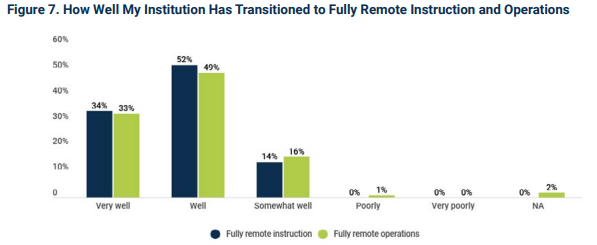
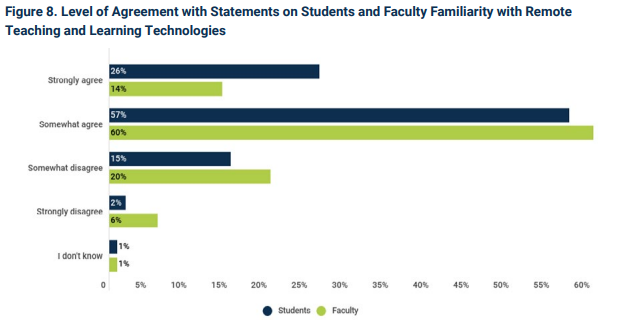
Post-traditional students (students of any age, but not enrolled in a full-time residential program) comprise upwards of 60 percent of all undergraduates (according to ACE) and 80 percent of graduates students. They have a strong preference for programs that are not delivered 100 percent in the classroom. A 2017 national study of these undergraduates (AMR, 2017 see below) indicates that only 18 percent prefer a classroom program, while 28 percent prefer a fully 100 percent online program. All others prefer programs that combine online, hybrid, and classroom courses.

Traditional students comprise about 40 percent of undergraduates and 20 percent of graduate students. To date, they are not as enthusiastic about online study. But why would they be? They didn’t choose online learning and are largely taking remote learning courses put together in a matter of days—and possibly lead by instructors who have only taught standing in front of students—instead of “fully baked” online courses. A recent study from SimpsonScarborough confirms this unsurprising finding.
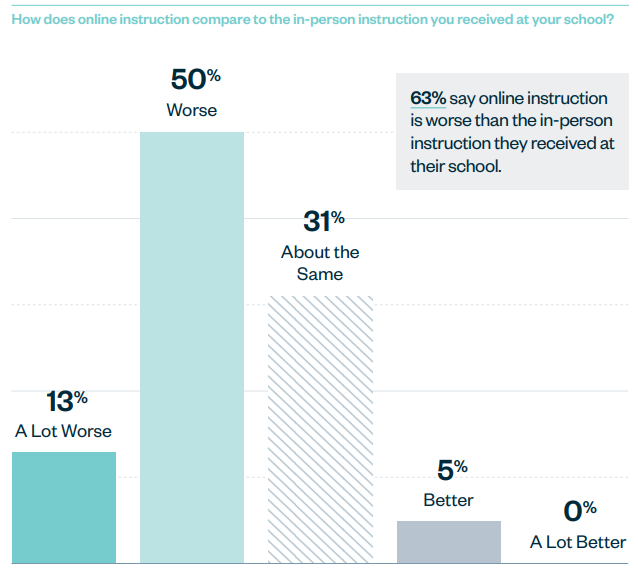
Although these students—and their families—are seeking a traditional experience with all that goes with going to college, most of us have also heard a young person we know say “I wish I could take these general eds online.” Paul LeBlanc at Southern New Hampshire is planning to combine online and traditional this fall (if he can): welcome students back and have online courses ready for them to take (where appropriate) in their dorm rooms, while retaining as much of the rest of the traditional campus experience as possible. He’s also planning to offer said education in the future for $10,000 per year, but that is a story for another day.
2) Develop synchronous online versions of upper division courses: Take what your faculty started this spring with synchronous distance learning and really work to enhance the pedagogy and design of this medium for upper division (major) courses.
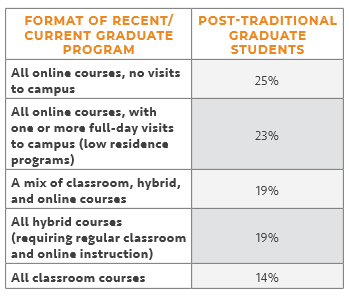
These upper-level courses are those that the majority of students would prefer to have delivered either in a classroom or in a high quality online experience that focuses on maximizing engagement with fellow students and the instructor.
Again, Aslanian Market Research (AMR) documented the demands and preferences of working professional post-traditional students (graduate students in this case) better than anyone. Their 2018 study documented that even more of this market segment (80 percent of all graduate students) seek online or hybrid programs.
In follow up research, AMR also documented that only about 20-25 percent of post-traditional populations at both levels indicated that they wanted NO synchronous activities in their online courses and programs. In fact, a majority indicated they would prefer weekly synchronous “virtual convenings with their instructor and classmates.”
3) Virtual student services: From counseling to advisement to accessing the writing center, institutions need to ensure that all critical student services are available online.
Many institutions have made forays into making their services available virtually, but this now really needs to be a priority. Putting your courses online is only half (will perhaps three-quarters of) the challenge. Online students, particularly those new to the medium, will need considerable support in order to be successful. In many cases these will be the same services—just with different delivery—but in some areas there will be new needs (e.g.: tech support will take on a whole new life, as will academic support and tutoring).
These services need to be available to all levels and types of students—permanently. Past experiences have demonstrated that once these services are available online, students embrace them and use them. It is an investment that will likely pay a dividend. Office hours may well be able to be reduced, and roles may be able to be combined. By employing a third-party call center for some of these services (particularly helpful for IT related issues), along with the implementation of a AI-driven chatbot (if they don’t already have one), are a few ways that institutions are investing in the future.
In an age when we are able to do everything from order our dinner to balance our checkbook to having a “virtual” therapy session, having all of your services available online will prepare you for the future—with or without any additional pandemics or natural disasters.
Don’t forget about career planning
The importance of good career planning services has been on the rise for many years—both among traditional students (who feel more pressure than ever to get a job after graduation) and post-traditional (who are likely enrolled in order to advance or change their careers). Career planning is also one of the most common areas reserved for traditional undergraduates. This is a mistake, and one that an online operation can facilitate. These services need to be available to all students, and such availability should be among the ways that institutions position themselves in the market. Aslanian and other studies were already documenting increased demand for these services among post-traditional undergrad AND grad students, and this will only grow in the recession that is coming upon us caused by the pandemic.
Let’s talk about your fall enrollment strategies for traditional, graduate, and online learning
Are you prepared to manage online enrollment and provide online learning continuity? I invite you to talk with us about how we can help, especially in light of RNL’s partnership with Kaplan.
Contact us today and we’ll set up a time to talk. Because regardless of how fall 2020 enrollment unfolds, the changes brought by COVID-19 will require institutions to adapt and adjust their enrollment strategies in the years to come.

